Interrelationship between yield and its contributing traits in wheat (Triticum aestivum L)
Bạn đang xem bản rút gọn của tài liệu. Xem và tải ngay bản đầy đủ của tài liệu tại đây (209.21 KB, 7 trang )
Int.J.Curr.Microbiol.App.Sci (2019) 8(2): 3209-3215
International Journal of Current Microbiology and Applied Sciences
ISSN: 2319-7706 Volume 8 Number 02 (2019)
Journal homepage:
Original Research Article
/>
Interrelationship between Yield and its Contributing Traits
in Wheat (Triticum aestivum L)
Samar Pratap Verma1, V.N Pathak1 and O.P. Verma2*
1
Department of Genetics and Plant Breeding S.M.M. Town PG. College- Ballia, (U.P.), India
2
Department Of Genetics and Plant Breeding N.D.U.A and T. Kumarganj,
Faizabad (U.P.), India
*Corresponding author
ABSTRACT
Keywords
Wheat, (Triticum
aestivum L), CoRelation,
Path coefficient
analysis
Article Info
Accepted:
22 January 2019
Available Online:
10 February 2019
A field experiment was conducted to study the character association for 11 yield
and its contributing traits in the 93 diverse indigenous genotypes of wheat
(including 3 checks) at agricultural research farm Nidharia of S.M.M. Town Post
Graduate College, Ballia during Rabi season 2017-2018. The experiment was laid
ou tin Augmented Block Design under normal irrigated condition following
standard cultural practices. The characters studied were days to 50% flowering,
days to maturity, plant height, tillers per plant, spike length, flag leaf area,
peduncle length, 1000-grain weight, biological yield per plant, harvest index and
grain yield per plant. The grain yield per plant showed highly significant and
positive correlation with tillers per plant, spike length, biological yield per plant,
harvest index and test weight. While Flag leaf area and plant height showed nonsignificant and positive correlation with grain yield per plant. The highest positive
direct effect on grain yield per plant was observed by biological yield per plant
followed by harvest index, days to 50% flowering, test weight and tillers per plant
while remaining traits showed negative direct effect on grain yield per plant.
Hence, for the development of high yielding wheat varieties these traits possessing
highly significant positive associations should be given more weightage in
breeding or selection program.
Introduction
Wheat, (Triticum aestivum L) world’s largest
self- pollinated crop of the cereal crop which
belongs to Gramineae (Poaceae) family of the
genus Triticum. It has been described as the
‘King of cereals’. Wheat is consumed in a
variety of ways such as bread chapatti,
porridge (Daliya), flour, etc. It is grown in
diversified environments. India is the second
largest producer of wheat after China. India’s
share in world, wheat production is about
14.65% of world’s wheat production. Wheat
may be compared well with other cereals in
nutritive value. There is much scope to breed
wheat varieties for higher yield coupled with
acceptable quality. It has good nutrition
profile with 12.1% protein, 1.8% lipids, 1.8%
3209
Int.J.Curr.Microbiol.App.Sci (2019) 8(2): 3209-3215
ash, 2.0% reducing sugars, 6.7% pentose,
59.2% starch, 70% total carbohydrates and
provides 314K cal/100g of food. It is also a
good source of minerals and vitamins viz.,
calcium (37 mg/100g), iron (4.1 mg/100g),
thiamine
(0.45mg/100g),
riboflavin
(0.13mg/100g)
and
nicotinic
acid
(5.4mg/100mg). During genetic improvement
of yield in crop plants selection and
hybridization
techniques
are
utilized
frequently. Selection is usually practiced for
pooling favorable genes, while hybridization
is predominantly utilized to accumulate
favorable genes in a variety for obtaining
better performance. Yield being a complex
character is a function of several component
characters and their interaction with
environment. Genotypic and phenotypic
correlation reveals the degree of association
between different characters and thus aid in
selection to improve the yield and yield
attributing characters simultaneously. Further,
path coefficient analysis helps in partitioning
of correlation coefficients into direct and
indirect effects and in the assessment of
relative contribution of each component
character to the yield.
Material and Methods
The experiment of present investigation was
conducted to evaluate the ninety three wheat
germplasm lines including three checks
(namely HD 2967, HI 8713, and SONALIKA)
in Augmented Block Design at Agricultural
Research Farm, Nidharia, S.M.M. Town Post
Graduate College, Ballia (U.P.). These
genotypes exhibited wide spectrum of
variation for various agronomical and
morphological characters. The experimental
field was divided into 9 blocks and 13 plots in
each block (10 test genotypes along with 3
checks) was accommodated in each block.
Each plot was consist of two rows of 2.5 m
length with spacing of 5 cm within the rows
and 25 cm between the rows. The
recommended cultural practices were followed
to raise a good normal crop. The observations
were recorded on ten randomly selected plants
from each plot except days to 50% flowering
and days to maturity. Ten competitive plants
from each plot were randomly selected for
recording observations for all the quantitative
characters except days to flowering and
maturity, which was recorded on the plot
basis. The data were recorded for the
following characters; days to 50% flowering,
days to maturity, plant height (cm), tillers per
plant, spike length (cm), peduncle length (cm),
flag leaf area (cm2), biological yield per plant
(g), harvest index (%), test weight (1000-grain
weight) (g) and grain yield per plant (g).
Statistical analysis was carried out according
to standard statically procedure (Federer,
1956). The simple correlations between
different characters were estimated according
to Searle (1961) while path coefficient
analysis following Dewey and Lu (1959) to
examine genetic interrelationships in existing
divers wheat genotypes.
Results and Discussion
The analysis of variance revealed highly
significant differs between the genotypes. The
grain yield or economic yield, in almost all the
crops, is the complex character which
manifests from multiplicative interactions of
several other characters that are termed as
yield components. The correlation coefficient
is the measure of degree of symmetrical
association between two variables or
characters which helps us in understanding the
nature and magnitude of association among
yield and yield components.
In the present investigation, simple correlation
coefficients were computed among 11
characters (Table 1). The grain yield per plant
exhibited highly significant and positive
association with tillers per plant, spike length,
biological yield per plant, harvest index and
3210
Int.J.Curr.Microbiol.App.Sci (2019) 8(2): 3209-3215
test weight. Thus, the high yielding wheat
genotypes are likely to possess higher
biological yield per plant, spike length, tillers
per plant, harvest index and test weight along
with undesirable tall stature, late flowering
and late maturity. The strong positive
associations of grain yield with characters
mentioned above have also been reported
earlier in wheat (Arya et al., 2005; Yadavet
al., 2006; Singh et al., 2008; Bisht and
Gahalian. 2009, Singh et al., 2010; Kumar et
al., 2014 and Phougat et al., 2017). The
biological yield per plant, having highest
positive correlation with flag leaf area, tillers
per plant and spike length, but it had negative
association with days to 50% flowering and
days to maturity. The strong positive
association of biological yield per plant with
the characters like flag leaf area, tillers per
plant and spike length which have increasing
effect on over all biomass production appears
logical.
Harvest index exhibited significant and
negative association with biological yield per
plant, flag leaf area and peduncle length.
Similarly, 1000-grain weight recorded highly
significant and positive nature with harvest
index and plan height. The above discussion
revealed that wheat genotypes with higher
grain yield and biomass production potential
had higher mean performance for tillers per
plant, spike length, biological yield per plant,
harvest index, test weight and flag leaf area.
Spike length showed highly significant and
positive correlation with peduncle length,
biological yield per plant and grain yield per
plant. Flag leaf area showed highly significant
and positive correlation with spike length and
biological yield per plant, and it’s also showed
significant and positive correlation with plant
height and peduncle length. This suggested
that the genotypes having large flag leaf area
had tall plant height, tall spike length, tall
peduncle length and highest biological yield.
Path coefficient analysis is a tool to partition
the observed correlation coefficient into direct
and indirect effects of yield components on
grain yield. Path analysis provides clearer
picture of character associations for
formulating efficient selection strategy. Path
coefficient analysis differs from simple
correlation in that it points out the causes and
their relative importance, whereas, the later
measures simply the mutual association
ignoring the causation. The results of path
coefficient analysis carried out using simple
correlation coefficients among 11 characters
are given in Table 2. Biological yield per plant
followed by harvest index, showed very high
positive direct contribution on grain yield per
plant. Thus, biological yield per plant and
harvest index emerged as major direct yield
components.
The available literature has also identified
biological yield per plant and harvest index as
important direct contributors to grain yield per
plant (Singh et al., 2012; Kumar et al., 2010;
Phougat et al., 2017). The direct effects of
remaining eight characters viz., days to 50%
flowering, days to maturity, flag leaf area,
plant height and peduncle length were very
low and non-significant indicating their
negligible direct contribution towards grain
yield.
The highest indirect effects of tillers per plant,
spike length and flag leaf area possessed high
order positive estimates via biological yield
per plant on grain yield per plant. Thus, the
above four characters emerged as most
important
indirect
yield
contributing
characters because they showed substantial
positive indirect effects on grain yield per
plant via biological yield per plant. The three
characters mentioned above have also been
found as important contributors to grain yield
in wheat as reported by earlier workers (Singh
et al., 2010; Anwar et al., 2009; Tripathi et al.,
2011).
3211
Int.J.Curr.Microbiol.App.Sci (2019) 8(2): 3209-3215
Table.1 Estimates of simple correlation coefficients between 11 characters in wheat
Character
Days to
50%
flowering
Flag leaf
area
(cm2)
Plant
height
(cm)
Days to
maturity
Tillers/
plant
Spike
length
(cm)
Peduncle
length
(cm)
Biological
yield/plant
(g)
Harvest
index (%)
Test
weight (g)
Grain
yield/plant
(g)
Days to
50%
Flowering
flag leaf area
(cm2)
r(g)
r(p)
-0.2501
-0.2235*
-0.1336
-0.1199
0.8691
0.8017**
0.0424
0.0197
-0.2362
-0.2032*
-0.1564
-0.1096
-0.0651
-0.0657
-0.0948
-0.0657
-0.2211
-0.2136*
-0.1156
-0.1016
r(g)
r(p)
0.1871
0.1991*
-0.1747
-0.1679
-0.2193
-0.1204
0.3485
0.3091**
0.2627
0.2111*
0.2032
0.2541**
-0.2334
-0.1971*
0.0942
0.1192
0.0333
0.0926
r(g)
r(p)
0.0199
0.0291
-0.1586
-0.1100
0.0724
0.0665
0.1085
0.1022
0.0118
0.0333
0.0802
0.0541
0.1874
0.1854**
0.0588
0.0615
r(g)
r(p)
-0.0441
-0.0816
-0.2209
-0.1789
-0.0258
-0.0341
-0.1823
-0.1396
0.0802
0.0572
-0.1825
-0.1588
-0.1958
-0.1193
r(g)
r(p)
-0.0215
-0.0072
-0.2825
-0.2093*
0.4608
0.4248**
0.0935
0.0434
-0.1445
-0.1056
0.4892
0.4265**
r(g)
r(p)
0.3285
0.3178**
0.3534
0.3099**
0.0184
0.0180
0.0943
0.0880
0.3198
0.2757**
r(g)
r(p)
0.2185
0.1283
-0.2690
-0.2213*
0.1792
0.1499
0.0221
-0.0268
r(g)
r(p)
-0.2661
-0.2093*
0.1437
0.1784
0.7910
0.7791**
r(g)
r(p)
0.4257
0.3937**
r(g)
r(p)
0.3054
0.3921**
0.3999
0.4093**
Plant
height (cm)
Days to
Maturity
Tillers/
Plant
Spike length
(cm)
Peduncle
length (cm)
Biological
yield/plant (g)
Harvest index
(%)
Test weight
(g)
Grain
yield/plant (g)
Significance Levels
If correlation r =>
r(g)
r(p)
0.05
0.1816262
0.01
0.2372597
3212
Int.J.Curr.Microbiol.App.Sci (2019) 8(2): 3209-3215
Table.2 Direct and indirect effects of 10 characters on grain yield per plant in wheat
Character
Days to
50% flowering
Flag
leaf
area
(cm2)
0.0097
Days to
0.0436
50%
flowering
Flag leaf
0.0049
area
0.0221
(cm2)
Plant
-0.0012
0.0020
height (cm)
Days to
-0.0488
0.0102
Maturity
Tillers/
0.0004
Plant
0.0025
Spike
0.0009
length (cm)
0.0013
Peduncle
0.0010
length (cm)
0.0019
Biological
-0.0581
0.2245
yield/plant
(g)
Harvest
-0.0369
index (%)
0.1108
Test weight
-0.0074
0.0041
(g)
Residual factor = 0.2597
Bold figures indicate direct effects.
Plant
height
(cm)
Days to
maturity
Tillers
/
plant
Spike
length
(cm)
Peduncle
length
(cm)
Biological
yield/plant
(g)
Harvest
index
(%)
Test
weight
(g)
Grain
yield/
plant (g)
0.0052
0.0350
0.0009
-0.0089
-0.0048
-0.0029
-0.0029
0.0093
-0.1016
0.0044
0.0037
0.0027
-00068
-0.0047
-0.0056
0.0043
0.0026
0.0926
0.0101
0.0003
0.0007
0.0010
0.0003
0.0005
0.0019
0.0615
0.0018
0.0023
0.0003
0.0009
0.0295
-0.0608
0.0011
0.0050
0.0109
0.0021
0.0085
-0.0035
0.0097
-0.1193
-0.0017
0.0211
-0.0002
-0.0044
0.0090
0.0009
0.4265**
0.0008
0.0000
-0.0042
-0.0013
-0.0013
-0.0001
0.0003
0.0019
-0.0028
-0.0089
-0.0011
0.0020
-0.1234
0.3754
0.2739
0.1133
0.8837
-0.1850
0.0022
0.0004
0.0013
0.1576
0.0304
0.0321
0.0244
0.0101
-0.1244
-0.1176
0.5620
0.2213
0.3921**
0.0064
-0.0055
0.0037
0.0031
0.0052
0.0062
0.0137
0.0347
04093**
3213
0.2757**
-0.0268
0.7791**
Int.J.Curr.Microbiol.App.Sci (2019) 8(2): 3209-3215
In contrast, tillers per plant and spike length
exerted high order positive indirect effect via
biological yield per plant and substantial
negative indirect effects via harvest index on
grain yield per plant. Similarly, 1000-grain
weight showed high order positive indirect
effect via harvest index. The biological yield
per plant, which had highest positive direct
effect on grain yield per plant, also exerted
considerable negative indirect effect on grain
yield per plant via harvest index. Thus,
characters like tillers per plant, spike length,
1000-grain weight, harvest index and
biological yield per plant may also be
considered as important indirect yield
components of complex nature due to their
contrasting positive and negative indirect
effects via one or other characters. Thus, these
five characters need special attention at the
time of formulation of selection strategy due
to their contrasting direct and indirect effects.
The occurrence of contrasting positive and
negative direct/indirect effect by same character
via one or another characters as observed in
present study is in conformity with earlier
reports of (Sachan and singh, 2003; Muhammad
and Ihsan, 2004) Majority of the estimates of
direct and indirect effects were too low to be
considered of any consequence. This may be
attributed to presence of very high genetic
variability and diversity in the fairly large
number of germplasm lines. The existence of
different character combinations in diverse
germplasm lines might have led to different
types of character associations in different lines.
Thus, presence of several contrasting types of
character associations and inter relationships
might have resulted into cancellation of
contrasting associations by each other ultimately
leading to lowering of the few estimates of
certain traits.
area and test weight emerged as most
important indirect yield components, while
days to 50% flowering, days to maturity,
1000-grain weight, harvest index and
biological yield appeared as important but
complex indirect yield contributors due to
their contrasting positive and negative indirect
effect via different characters. These findings
are in close association with the results of
Subhani, 2000; Singh et al., 2010; It reflex
that emphasis should be given to select the
above mentioned traits to enhance the
production and productivity of wheat under
irrigated conditions in northern- eastern plane
zone.
References
In the present study, path analysis reflected
that biological yield per plant, harvest-index
and test weight as important direct yield
contributing characters. On the other
handtillers per plant, spike length, flag leaf
Analysis for some metric traits in wheat.
International J. Agric. Biology,
Pakistan. 6 (1): 138-142.
Anwar, J., Ali, M. A., Hussain, M., Sabir, W.,
Khan, M. A., Zulkiffal, M. and
Abdullah, M. (2009). Assessment of
yield criteria in bread wheat through
correlation and path analysis. JAPS, J.
Animal and Plant Sci. 19 (4): 185-188.
Arya, V. D.; Pawar, I. S.; Lamba, R. A. S.
(2005).Genetic variability, correlation
and path analysis for yield and quality
traits in bread wheat. Haryana
Agricultural University Journal of
Research. 35(1):59-63. 7
Bisht
and Gahalain,
S.
S
(2009).
Interrelationships and path coefficient
analysis in wheat germplasm of
Kumaun Himalayas. Vegetos. 22 (2):
19-26.
Dewey, D.R. and Lu, K.H. 1959. A
correlation and path analysis of
components of crested wheat grass
seed production. Agron. J. 57: 515518.
Federer, W. T. 1956.Augmented Designs.
Hawaii Planters’ Record LV. (2): 191208.
3214
Int.J.Curr.Microbiol.App.Sci (2019) 8(2): 3209-3215
Kumar, H., Khosla, G. and Sharma, P. K.
(2010).
Utilization
of
genetic
variability, correlation and path
analysis for seed yield improvement in
bread wheat (Triticum aestivum L.)
genotypes. Environment and Ecology.
28(1): 91-94.
Kumar, Y., Lamba, R. A. S.; Balbir
Singh; Vinod Kumar. (2014). Genetic
variability, correlation and path
analysis in wheat varieties under late
sown condition. Annals of Agri Bio
Research. 19(4):724-727.
Muhamad, K. And Ihsan, K. 2004.
Heritability, correlation and pathcoefficient
Phougat Divya; Panwar, I. S., Saharan, R.
P., Vikram Singh; AnuradhaGodara.
(2017).
Genetic diversity
and
association studies for yield attributing
traits
in
bread wheat [Triticum
aestivum (L.) em.Thell]. Research on
Crops. 18 (1): 139-144.
Sachan, M.S. And Singh, S.P., 2003. Genetics
of yield and its components in durum
wheat (T. durum Desf.). Journal of
Inter Academicia. 7 (2): 140- 143.
Searle, S.R. 1961. Phenotypic, genotypic and
environmental correlations. Biometrics.
17: 474-480.
Singh, A. K., Singh, S. B., Singh, A.
P., Sharma, A. K. (2012). Genetic
variability, character association and
path analysis for seed yield and its
component
characters
in wheat
(Triticum aestivum L.) under rainfed
environment. Indian
Journal
of
Agricultural Research. 46(1): 48-53.
Singh, B. N., Vishwakarma, S. R. and Singh,
V. K. (2010). Character association
and path analysis in elite lines of wheat
(Triticum aestivum L.). Plant Archives,
10 (2): 845-847
Singh, S. K., Singh, B. N., Singh, P. K.,
Sharma, C. L. (2008). Correlation and
path analysis in some exotic lines in
wheat (Triticum aestivumL.). New
Botanist. 35(¼): 89-94
Subhani, G.M., 2000. Correlation and pathcoefficient analysis in bread wheat
Tripathi, G.P. Parde, N.S. Zate, D.K. Lal,
G.M. (2014) Genetic variability and
heritability studies on bread wheat
(Triticum aestivum L.). International
Journal of Plant Sciences, 10(1):57-59.
Under drought stress and normal conditions.
Pakistan J. Biological Sci. 3(1): 72-77.
Yadav, D. K., Pawar, I. S., Sharma, G.
R., Lamba, R. A. S. (2006). Evaluation
of
variability
parameters
and path analysis in
bread
wheat.
National
Journal
of
Plant
Improvement. 8(1): 86-89.
How to cite this article:
Samar Pratap Verma, V.N Pathak and Verma, O.P. 2019. Interrelationship between Yield and
its Contributing Traits in Wheat (Triticum aestivum L.) Int.J.Curr.Microbiol.App.Sci. 8(02):
3209-3215. doi: />
3215
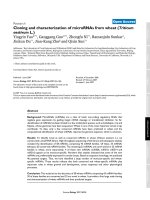
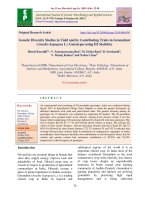
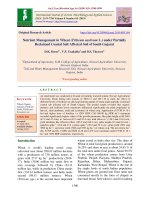
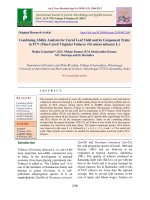
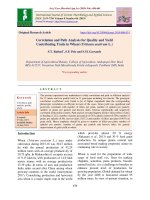
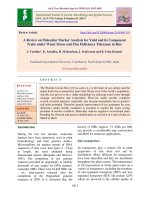
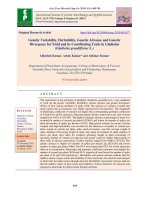
![Genetic parameters for grain yield and nutritional quality traits in foxtail millet [Setaria italica (L.) Beauv.]](https://media.store123doc.com/images/document/2020_01/13/medium_tvq1578927783.jpg)
![Genetic variability studies in F2 segregating populations for yield and its component traits in Okra [Abelmoschu sesculentus (L.)Moench]](https://media.store123doc.com/images/document/2020_01/13/medium_nxs1578931693.jpg)
